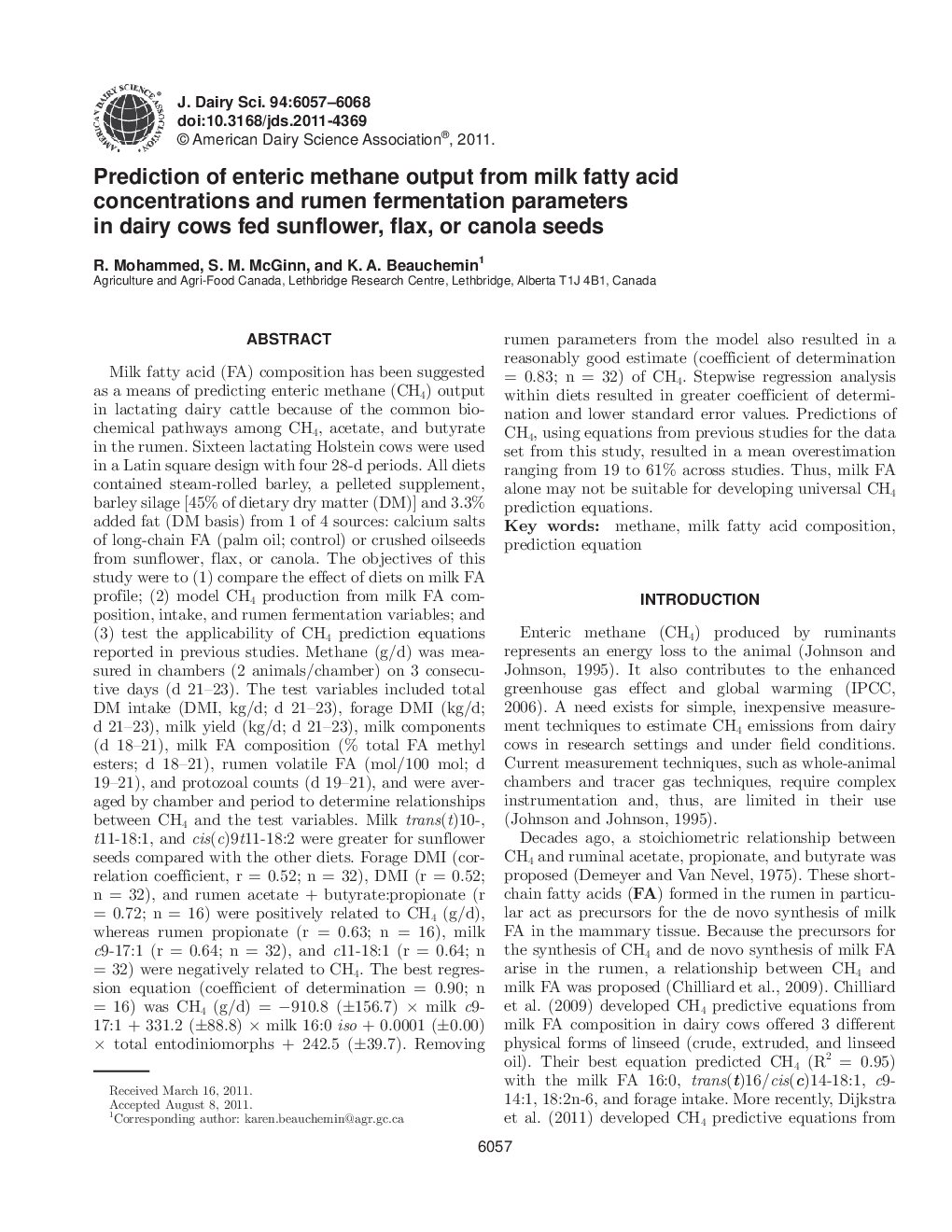| کد مقاله | کد نشریه | سال انتشار | مقاله انگلیسی | نسخه تمام متن |
|---|---|---|---|---|
| 10981699 | 1108078 | 2011 | 12 صفحه PDF | دانلود رایگان |
عنوان انگلیسی مقاله ISI
Prediction of enteric methane output from milk fatty acid concentrations and rumen fermentation parameters in dairy cows fed sunflower, flax, or canola seeds
دانلود مقاله + سفارش ترجمه
دانلود مقاله ISI انگلیسی
رایگان برای ایرانیان
کلمات کلیدی
موضوعات مرتبط
علوم زیستی و بیوفناوری
علوم کشاورزی و بیولوژیک
علوم دامی و جانورشناسی
پیش نمایش صفحه اول مقاله

چکیده انگلیسی
Milk fatty acid (FA) composition has been suggested as a means of predicting enteric methane (CH4) output in lactating dairy cattle because of the common biochemical pathways among CH4, acetate, and butyrate in the rumen. Sixteen lactating Holstein cows were used in a Latin square design with four 28-d periods. All diets contained steam-rolled barley, a pelleted supplement, barley silage [45% of dietary dry matter (DM)] and 3.3% added fat (DM basis) from 1 of 4 sources: calcium salts of long-chain FA (palm oil; control) or crushed oilseeds from sunflower, flax, or canola. The objectives of this study were to (1) compare the effect of diets on milk FA profile; (2) model CH4 production from milk FA composition, intake, and rumen fermentation variables; and (3) test the applicability of CH4 prediction equations reported in previous studies. Methane (g/d) was measured in chambers (2 animals/chamber) on 3 consecutive days (d 21-23). The test variables included total DM intake (DMI, kg/d; d 21-23), forage DMI (kg/d; d 21-23), milk yield (kg/d; d 21-23), milk components (d 18-21), milk FA composition (% total FA methyl esters; d 18-21), rumen volatile FA (mol/100 mol; d 19-21), and protozoal counts (d 19-21), and were averaged by chamber and period to determine relationships between CH4 and the test variables. Milk trans(t)10-, t11-18:1, and cis(c)9t11-18:2 were greater for sunflower seeds compared with the other diets. Forage DMI (correlation coefficient, r = 0.52; n = 32), DMI (r = 0.52; n = 32), and rumen acetate + butyrate:propionate (r = 0.72; n = 16) were positively related to CH4 (g/d), whereas rumen propionate (r = 0.63; n = 16), milk c9-17:1 (r = 0.64; n = 32), and c11-18:1 (r = 0.64; n = 32) were negatively related to CH4. The best regression equation (coefficient of determination = 0.90; n = 16) was CH4 (g/d) = â910.8 (±156.7) à milk c9-17:1 + 331.2 (±88.8) à milk 16:0 iso + 0.0001 (±0.00) à total entodiniomorphs + 242.5 (±39.7). Removing rumen parameters from the model also resulted in a reasonably good estimate (coefficient of determination = 0.83; n = 32) of CH4. Stepwise regression analysis within diets resulted in greater coefficient of determination and lower standard error values. Predictions of CH4, using equations from previous studies for the data set from this study, resulted in a mean overestimation ranging from 19 to 61% across studies. Thus, milk FA alone may not be suitable for developing universal CH4 prediction equations.
ناشر
Database: Elsevier - ScienceDirect (ساینس دایرکت)
Journal: Journal of Dairy Science - Volume 94, Issue 12, December 2011, Pages 6057-6068
Journal: Journal of Dairy Science - Volume 94, Issue 12, December 2011, Pages 6057-6068
نویسندگان
R. Mohammed, S.M. McGinn, K.A. Beauchemin,